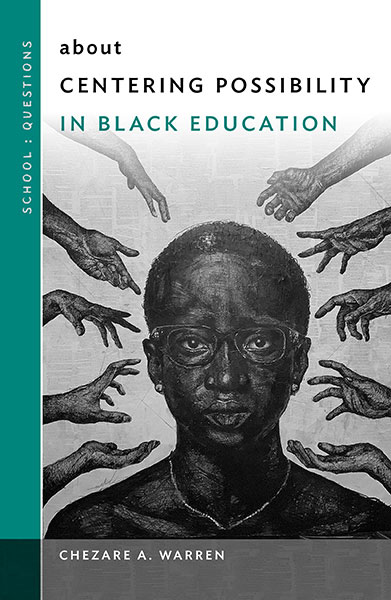Professors: Request an Exam Copy
Print copies available for US orders only. For orders outside the US, see our international distributors.
Publication Date: April 30, 2021
Pages: 160
Series: School : Questions

Improving education outcomes for Black students begins with resisting racist characterizations of blackness. Chezare A. Warren, a nationally recognized scholar of race and education equity, emphasizes the imperative that possibility drive efforts aimed at transforming education for Black learners. Inspired by the “freedom dreaming” of activists in the Black radical tradition, the book is comprised of nine principles that clarify how centering possibility actively refuses limitations for what Black people can create, accomplish, and achieve. This interdisciplinary volume also features over 30 original images, poems, and lyrics by Black artists from around the United States, each helping to breathe new life into the concept of possibility and its relevance to remaking Black children’s experience of school. Warren draws on research in history, cultural studies, and sociology to cast a vision of Black education futures unencumbered by antiblackness and White supremacy. This justice-oriented text will inspire innovative solutions to eliminating harm and generating education alternatives that Black students desire and deserve.
Book Features:
Chezare A. Warren is an associate professor of equity and inclusion in education policy at Vanderbilt University’s Peabody College. He received the 2024 Society of Professors of Education (SPE) Charles DeGarmo Award.
“ About Centering Possibility in Black Education, by Dr. Chezare Warren, is a welcomed perspective shift in viewing Black education, and is a must-read for all practitioners who interact with Black and Brown students.”
—Teachers College Record
“What happens when freedom meets possibility? Dr. Warren and contributing authors offer dreams for excellence, brilliance, activism, and creativity toward the notion of revealing what is possible for Black education.”
—Gholnecsar Muhammad, associate professor of language and literacy, Georgia State University
“The thrust of this book moves in a direction that embraces a profit perspective, full of the grace found fluid in an exceptional love for Black youth. about Centering Possibility in Black Education is, thus, an important revising of science (or a scientific position) in relation to the Black body, premised on the idea that Black youth are not okay in U.S. schools, that U.S. schools are places of extraordinary suffering for Black children. Yet the book doesn’t end here; rather, it dares to move readers to a separate place—what Warren calls ‘possibility.’”
—David E. Kirkland, vice dean of equity, belonging, and community action, New York University
Contents (Tentative)
1. Introduction
Freedom Dreaming . . .
Key Concepts
Reframing Blackness Away from Peril Towards Possibility
Centering Possibility in Black Education Transformation
“Melanin” by Mahogany Jones
2. Resistance
Why Resistance? “Centering Possibility” Principle #1
“Black Constitution” by Angel Hart
3. Dreaming
Why Dreaming? “Centering Possibility” Principle #2
“Black Girl Magic” by Mahogany Jones
4. Storytelling
Why Storytelling? “Centering Possibility” Principle #3
What You Must Remember about Storytelling
“My Name Is” by Jason “Squeeze” Ford
5. Creativity
Why Creativity? “Centering Possibility” Principle #4
“Code Switched” by Tony Keith, Jr.
6. Thriving
What is Thriving? “Centering Possibility” Principle #5
The Essentials of Thriving
The Anatomy of Thriving: Strengthening the Tie that Binds
“A Different World” by Angel Hart
7. Community
What is Community? “Centering Possibility” Principle #6
Building & Sustaining Collective Wellbeing
“May You Ever” by Timothy Welbeck
8. Reparations
(coauthored with Terrence A. Pruitt)
What are Reparations? “Centering Possibility” Principle #7
Healing & Reconciliation in School Discipline: The Case for Restorative Justice
“Black Bodies” by Jason “Squeeze” Ford
9. Environment
What is Environment? “Centering Possibility” Principle #8
Making Environments that Enable Black People’s Breathing
“We Are Your Voices” by Angel Hart
10. Teaching
What is Teaching and Who Counts as Teachers? “Centering Possibility” Principle #9
Grassroots Organizing and Black (Education) Futures
Epilogue
Notes
Index
About the Author and the Artists
2024 Society of Professors of Education (SPE) Charles DeGarmo Award for Chezare A. Warren
Professors: Request an Exam Copy
Print copies available for US orders only. For orders outside the US, see our international distributors.